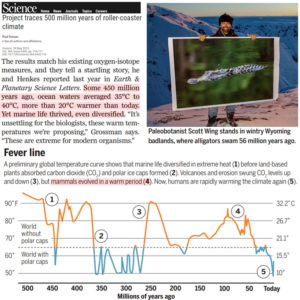by K. Richard, July 1, 2019 in NoTricksZone
Marine species evolved, thrived, and diversified in 35 to 40°C ocean temperatures and CO2 concentrations “5-10x higher than present-day values” (Voosen, 2019 and Henkes et al., 2018).

Image Source: Voosen, 2019
I. The insignificance of modern “global warming”
Today’s ocean temperatures average about 16°C. CO2 levels hover around 400 parts per million (0.04%).
The oceans have warmed at a rate of just 0.015°C per decade since 1971 in the 0-700 m layer according to the IPCC (2013). This warming rate isn’t detectable when considering overall long-term changes in this layer (Rosenthal et al., 2017) during the Holocene.
…
by British Antarctic Survey, June 19, 2019 in ScienceDaily
The K-Pg extinction wiped out around 60% of the marine species around Antarctica, and 75% of species around the world. Victims of the extinction included the dinosaurs and the ammonites. It was caused by the impact of a 10 km asteroid on the Yucatán Peninsula, Mexico, and occurred during a time period when the Earth was experiencing environmental instability from a major volcanic episode. Rapid climate change, global darkness, and the collapse of food chains affected life all over the globe.
The K-Pg extinction fundamentally changed the evolutionary history of life on Earth. Most groups of animals that dominate modern ecosystems today, such as mammals, can trace the roots of their current success back to the aftermath of this extinction event.
A team of scientists from British Antarctic Survey, the University of New Mexico and the Geological Survey of Denmark & Greenland show that in Antarctica, for over 320,000 years after the extinction, only burrowing clams and snails dominated the Antarctic sea floor environment. It then took up to one million years for the number of species to recover to pre-extinction levels.
…
by University of Exeter, June 19, 2019 in ScienceDaily/from Nature
A team of scientists have given a fresh insight into what may have driven the “Cambrian Explosion” — a period of rapid expansion of different forms of animal life that occurred over 500 million years ago.
While a number of theories have been put forward to explain this landmark period, the most credible is that it was fuelled by a significant rise in oxygen levels which allowed a wide variety of animals to thrive.
The new study suggests that such a rise in oxygen levels was the result of extraordinary changes in global plate tectonics.
During the formation of the supercontinent ‘Gondwana’, there was a major increase in continental arc volcanism — chains of volcanoes often thousands of miles long formed where continental and oceanic tectonic plates collided. This in turn led to increased ‘degassing’ of CO2 from ancient, subducted sedimentary rocks.
This, the team calculated, led to an increase in atmospheric CO2and warming of the planet, which in turn amplified the weathering of continental rocks, which supplied the nutrient phosphorus to the ocean to drive photosynthesis and oxygen production.
…
by Molecular Biology and Evolution (Oxford University Press), February 5, 201 in ScienceDaily
Ever since Darwin first set foot on the Galapagos, evolutionary biologists have long known that the geographic isolation of archipelogos has helped spur the formation of new species.
Now, an international research team led by Theresa Cole at the University of Otago, New Zealand, has found the same holds true for penguins. They have found the first compelling evidence that modern penguin diversity is driven by islands, despite spending the majority of their lives at sea.
“We propose that this diversification pulse was tied to the emergence of islands, which created new opportunities for isolation and speciation,” said Cole.
Over the last 5 million years, during the Miocene period, (particularly within the last 2 million years), island emergence in the Southern Hemisphere has driven several branches on the penguin evolutionary tree, and also drove the more recent influence of human-caused extinctions of two recently extinct penguin species from New Zealand’s Chatham Islands.
…
La géologie, une science plus que passionnante … et diverse

